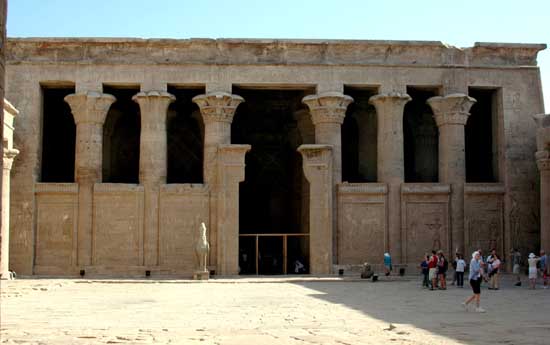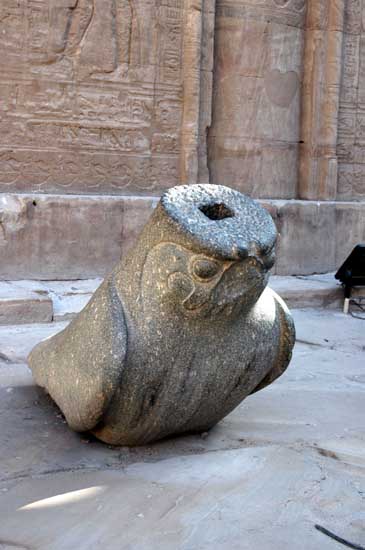


Horus was originally the sky-god of the
Nile Valley, whose eyes were the sun and moon, the falcon deity Horns was soon
assimilated into the Osirian myth as the child of Isis and Osiris. Raised in the
swamps of the Delta by Isis and Hathor, Horus set out to avenge his father's
murder by his uncle Seth. During their titanic struggle at Edfu, Horns lost an
eye and Seth his testicles. Despite this, Seth almost prevailed until Isis
intervened on her son's behalf and Osiris pronounced judgement upon them from
the netherworld, exiling Seth back to the wilderness and awarding the throne to
Horus. Thus good triumphed over evil and Osiris "lived" through his son.
All pharaohs claimed to be the incarnation of Horus the "living king" and
reaffirmed their divine oneness in an annual Festival of Coronation. A live
falcon was taken from the sacred aviary, crowned in the central court and then
placed in an inner chamber where it "reigned" in the dark for a year as the
symbol of the living king. Another event, sometimes called the Festival of
Triumph, commemorated the Contendings of Seth and Horns in a series of Mystery
Plays. At the equally lavish Feast of the Beautiful Meeting, his wet nurse and
wife Hathor sailed from Dendara aboard the Lady of the Lake to be met near Edfu
by his own barque, The First Horus. Public ceremonies preceded their conjugal
encounters in the privacy of the temple's sanctuary. Besides these festivals,
Horns also underwent a reunion with the sun-disc at New Year, similar to
Hathor's at Dendara.
To
complicate the cult of Horns still further, he was also associated with the
Divine Ennead of Heliopolis and another variant of the Creation myth. Having
distinguished the Osirian Horns from the Heliopolitan deity by terming the
latter Horus the Elder, the Egyptians split him into archetypes such as Herakhte
(often conjoined with Re), Hariesis (stressing his kinship to Isis) and
Haroeris. His priesthood asserted a place for Horus in the Creation myth by
crediting him with building the first house amidst swamps at the dawn of the
world, or even laying the Cosmic Egg whence the sun-god hatched. In rituals
associated with the Myth of the Great Cackler, they launched a goose onto the
sacred lake near Edfu temple, whose egg contained air and the potential for life
- crucial elements in the world's creation.
Temple of Horus at Edfu, Egypt.